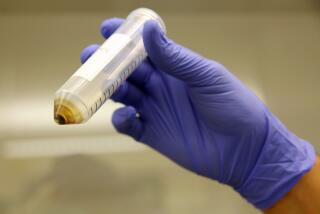FDA issues new rules for sunscreen labeling
The Food and Drug Administration issued new guidelines Tuesday for sunscreen labeling that will give consumers better information about the products’ effectiveness and that will, for the first time, allow the bottles, tubes and sprays to say that sunscreens protect against skin cancer and early skin aging.
The agency has been considering such regulations since 1978 and released some proposed rules in 2007, but subsequently concluded that the labeling system under consideration would be too confusing for consumers.
The new guidelines are designed “to reduce consumer confusion,” said Dr. Janet Woodcock, director of the FDA’s Center for Drug Evaluation and Research.
The agency has developed new protocols for testing the products’ effectiveness at blocking the sun’s damaging ultraviolet rays. Under the new guidelines, sunscreens may be labeled “broad spectrum” if they block UVB radiation and a percentage of UVA radiation. UVB is the major cause of sunburn, while both UVA and UVB cause early skin aging and skin cancer.
Products that are broad spectrum and have a sun protection factor of 15 or higher may be labeled to say that they reduce the risk of skin cancer and premature skin aging. Conversely, those that are not broad spectrum or that have an SPF lower than 15 will be required to carry a warning that they have not been shown to reduce such risks.
Sunscreens will no longer be able to claim to have a specific SPF above 50: The highest category now will be 50+. “We don’t have sufficient data to show that those with an SPF higher than 50 provide greater protection,” Woodcock said.
Products will no longer be allowed to be labeled as sun blocks because there is no evidence that they block all the radiation in sunlight. Products also may no longer be labeled “waterproof” or “sweat proof.” Instead, they can only be called “water resistant,” and labels must state clearly how long such protection lasts — either 40 minutes or 80 minutes.
Labels with these new requirements must be in place by summer 2012, Woodcock said, but the agency hopes that companies will implement them sooner.
Woodcock also noted that there had been some concern about sunscreens containing nanoparticles of zinc oxide or titanium dioxide, which block sunlight. Some critics have suggested that the extremely small particles can penetrate the skin and cause health problems.
But Woodcock said the agency had recently performed animal testing and found that the nanoparticles do not penetrate the skin. The findings are in agreement with studies that have been published in scientific journals, and there is currently no evidence to suggest that other chemicals commonly used in sunscreens are dangerous, she added.
Dr. Ronald L. Moy, president of the American Academy of Dermatology, praised the FDA action and said it could help reduce the incidence of skin cancer.
“For a long time, we have needed clear information about sunscreens,” said Moy, who is also a clinical professor of dermatology at UCLA’s David Geffen School of Medicine. “Now we have simple, consistent labeling requirements.”
An estimated 3.5 million Americans develop skin cancer each year, Moy said. Basal cell carcinoma, squamous cell carcinoma and melanoma are readily curable if detected early, but melanoma that has spread throughout the body is exceptionally difficult to treat and generally proves fatal, he said. “Every hour, an American dies of melanoma,” he said.
All types of skin cancers are increasing in young people, especially females, he noted. Researchers attribute that to the propensity of young women to bask in the sun and to use dangerous indoor tanning beds.
The academy recommends that people use a sunscreen with an SPF of at least 30, and most people do not use enough, Moy said. People should use about one ounce to cover their bodies, a glob about the size of a golf ball.






